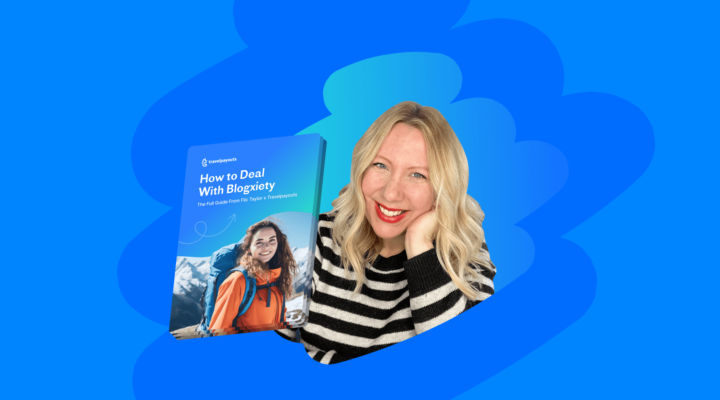Embracing Diversification in Travel Blogging
Many travel bloggers find comfort in sticking to their primary blog platform, fearing the risk of stretching their efforts too thinly across multiple platforms. But it’s important to realize that diversification is not just a desirable approach in the ever-evolving digital landscape—it’s necessary.
Let’s break it down. First, let’s talk about income streams. When you diversify your online presence, you create multiple income streams. This means you’re not relying solely on one channel for your revenue. Your travel blog may be bringing in thousands of dollars per month, but what happens if it experiences a sudden drop in traffic? That could significantly impact your earnings. In an unpredictable online environment, where algorithms and audience behaviors can change rapidly, diversification helps ensure your survival and growth. If one channel underperforms, others can pick up the slack. In essence, you aren’t putting all your eggs in one basket.
Diversification also offers you the opportunity to reach broader and more diverse audiences. Different platforms attract different demographics, and by leveraging this, you can appeal to various reader preferences. For instance, some people prefer watching videos, while others enjoy listening to podcasts or reading in-depth blog posts. Catering to these different preferences can broaden your reach, improve your influence, and, ultimately, increase your revenue. By embracing diversification, you’ll not only create additional income streams but also safeguard yourself and your business against potential risks while increasing your reach and influence.
Expanding Beyond Your Blog: Other Content Platforms and Channels
If you are looking to expand beyond your blog, one of the key things you should do is be more active on social media platforms like Facebook, Twitter, Instagram, and TikTok. These platforms allow you to establish a more personal connection with your audience and can act as mini-blogs themselves. What does that mean exactly? Well, social media also hold its own. It has the potential to attract and engage audiences independently, bringing in revenue without the backing of a primary blog. Through regular posts, stories, or short videos, you can share your travel experiences, recommendations, engage in real-time with your followers, and (obviously) earn money.
Let’s look a TikTok and Instagram. Both channels are powerful monetization tools if you implement the right strategy. Take what you write on your blog and cut it into bite-size pieces of information for people to consume on social media. Highlight an experience, shoot a video answering a question about a destination, or list your five favorite travel items. From there, create a call-to-action (CTA) to the link in your bio, where you’ll have a list of your offerings. Here you add a link to your blog but also affiliate links, free (or paid) travel guides, custom itineraries, and 1-on-1 consultations—the sky’s the limit.
Over time, if you post consistently, you’ll grow your following, allowing you to monetize your influence even further. Other income streams might pop up, like brand partnerships. Social media has the potential to create an independent income stream that can be quite profitable.
Along with monetization opportunities, these channels are also the perfect avenue to build a loyal community. Consider creating a Facebook group as an extension of your blog. Take a cue from travel blogger Sharon Gourlay, who’s done a great job with her niche website about Malaysia. She’s created a Facebook group, Malaysia Travel Planning – Dive In!, where members share tips, experiences, and travel hacks. Creating your community enriches your brand and provides a more intimate platform for engagement.
Developing a YouTube Presence: Engaging Travel Videos
With its vibrant cultures, stunning landscapes, and unique experiences, travel is inherently visual. It thrives on the power of show, not just tell. In the digital age, there’s no better platform for showcasing this immersive, visual element of travel than YouTube.
As the second-largest search engine in the world, YouTube offers a wealth of opportunities for travel bloggers. By developing a presence here, you’re not just telling your travel stories; you’re showing them, engaging with a broader audience, and expanding your influence. Viewers can virtually join your journey, exploring the world through your lens, a feature that heightens the impact of your content.

A well-optimized YouTube channel can earn you more views, higher engagement, and another income stream. Monetization on YouTube comes in different forms: ad revenue, channel memberships, merchandise shelf, super chat, and YouTube Premium revenue. Impactful travel clips and videos can earn you a loyal audience, increase your influence, and add another revenue stream to your blogging business.
Podcasting for Travel Bloggers: Sharing Expertise in Audio Format
Venturing into the world of podcasting can open doors to a new realm of connection, content creation, and revenue. Firstly, podcasts allow you to deepen your connection with your audience. Listeners feel part of a conversation, making them more likely to engage and invest in your content. Podcasts also enable you to bring other voices into the mix—you can host interviews with travel experts, share unique cultural experiences, or highlight travel tips from locals, fostering a sense of community and enhancing your content’s value.
Moreover, podcasts can also be another possible revenue stream. By incorporating ad placements or sponsored messages, you can monetize your episodes. Alternatively, if you decide to go the premium content route, you can offer exclusive episodes or bonus material for a fee. And remember, podcasts are not limited to audio platforms—you can record your sessions and upload them to YouTube, multiplying your content reach and monetization possibilities.
Building an Email List: Nurturing Direct Audience Connection
As a travel blogger, it’s essential to remember one golden rule: the only things you truly own online are your website and your email list. While social media platforms are excellent for reaching and engaging your audience, you don’t have total control over these channels. In contrast, an email list is yours and yours alone. It’s immune to algorithm shifts, providing you with a direct line of communication to your audience.
An email list might seem old-fashioned but don’t underestimate its power. Ask yourself, when was the last time you changed your email address? Most people stick with the same one for years, even decades. That’s the beauty of email marketing—it provides a long-term, consistent connection to your audience.
The strategy to build an email list dovetails perfectly with the content diversification we’ve already discussed. Use all the platforms at your disposal—your blog, social media channels, YouTube, and podcast—to drive sign-ups to your email list. Craft compelling CTAs encouraging your followers to subscribe, offering them valuable resources, tips, and exclusive content. Once people subscribe, you can build a more intimate relationship, nurturing their trust through regular, valuable content.

Now comes the monetization part. An email list is not just a medium for sharing content; it’s a potential sales channel. Once you’ve established trust and delivered value, you can introduce your products, services, or affiliate recommendations to your audience. If done right, these emails don’t come across as pushy sales tactics but rather helpful suggestions or opportunities. Always remember the goal is to provide value—whether that’s through high-quality content or carefully curated product recommendations.
Guest Blogging and Collaborations: Reaching New Audiences
Guest blogging is the practice of contributing content to another blogger’s website. The idea here is twofold: first, you’re given a platform to share your knowledge and experiences with a new, potentially larger audience. Second, you can leverage the opportunity to secure backlinks to your blog. These backlinks not only direct new traffic to your website but also improve your site’s SEO, increasing its visibility on search engines.
On top of that, collaborations with other bloggers in your niche can lead to mutually beneficial outcomes. These can be as simple as content collaborations, co-hosting events, or creating joint products/services. Collaborations foster a sense of community and can lead to lasting relationships that extend beyond a single project. By working together, you can share audiences and amplify your reach.
Remember, in the world of travel blogging, other bloggers aren’t your competition—they’re potential collaborators. As the saying goes: nothing of significance is ever accomplished alone.
Hosting Workshops and Webinars: Sharing Knowledge and Connecting With Enthusiasts
For a more intimate and interactive way to connect with your audience, consider hosting workshops or webinars. These platforms provide an ideal space for sharing your knowledge, showcasing your expertise, and establishing yourself as an expert in the travel blogging world.
Hosting webinars allows you to dive deeper into topics you’re passionate about, offer exclusive tips and tricks, and provide valuable, educational content to your followers. These sessions can be either free or paid. If you opt for the former, consider requesting attendees’ emails as a form of admission. This not only gives you a new contact for your email list but also helps grow a base of followers genuinely interested in what you have to offer.
Workshops and webinars can be an effective means to strengthen connections with your audience, build credibility, and generate leads for your email list—a win-win situation for all.
Planning and Organizing Travel Events or Trips
Taking your audience from the digital world to the physical world, planning and organizing travel events or trips can be a game-changer in your travel blogging career. It’s an opportunity to transform your online community into a tangible, interactive group, offering them the chance to connect with you and each other in person while experiencing the destinations and activities you promote.
Several successful travel bloggers have already ventured into this domain, such as Kiersten Rich of “The Blonde Abroad,” who launched TBA Escapes—curated, all-female travel tours and educational retreats. This initiative, just like others, operates independently of her blog, providing yet another diversified revenue stream.

Hosting your travel events or trips can not only elevate your brand but also create deeper, lasting connections with your followers. Plus, it adds another dimension to your business model, enhancing your income and extending your influence in the travel industry.
Monitoring and Adapting: Analyzing Performance and Adjusting Strategy
Above all else, when embracing diversification, make sure always to monitor your progress and adapt your strategies based on performance. Understanding your audience is the bedrock of successful content creation. Who are they? What do they want? Where are they most active? These insights can guide your efforts and inform your content strategy across all platforms.
Start by focusing on one or two platforms, mastering them before moving on to the next. This approach allows you to invest quality time and effort without spreading yourself too thin. As you track your performance across platforms, take note of what’s working and what’s not. Are your travel videos gaining more traction on YouTube than on Instagram? Does your audience respond better to podcasts than to written content?
Regular analysis will help you tweak your approach, pivot when necessary, and avoid burnout. Remember, it’s about running a sustainable business that’s capable of adaptation and resilience in an ever-changing digital landscape.
Final Thoughts: Creating Unique Travel Blogs
Creating unique travel blogs is no longer just about writing engaging posts and sharing breathtaking photos. It requires leveraging various platforms, diversifying content formats, and constantly adapting strategies to meet audience preferences. Whether it’s nurturing a social media community, creating immersive travel videos on YouTube, sharing experiences via podcasts, or even hosting travel events, the opportunities are endless.
Each platform and format not only presents a chance to connect with a wider audience but also opens up new revenue streams, making your travel blogging venture more sustainable and profitable. Remember, diversification isn’t just a strategy—it’s a necessity. Forge your unique path, embrace diversification, and turn your passion for travel into a thriving online presence.





